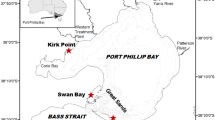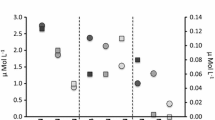Abstract
The allometric scaling of resource demand and translocation within seagrass clones to plant size (i.e. shoot mass and rhizome diameter), shoot production and leaf turnover was examined in situ in eight seagrass species (Cymodocea nodosa, Cymodocea serrulata, Halophila stipulacea, Halodule uninervis, Posidonia oceanica, Thalassodendron ciliatum, Thalassia hemprichii and Zostera noltii), encompassing most of the size range present in seagrass flora. One fully developed shoot on each experimental rhizome was incubated for 2–3 h with a pulse of NaH13CO3 (235 μmol) and 15NH4Cl (40 μmol). The mobilisation of incorporated tracers across the clone was examined 4 days later. Carbon and nitrogen demand for shoot production across seagrass species scaled at half of the shoot mass, whereas seagrass leaves incorporated tracers (13C and 15N) at rates proportional to the shoot mass. The shoots of all seagrass species shared resources with neighbours, particularly with younger ones. The time scales of physiological integration and the absolute amount of resources shared by seagrass ramets scaled at 2.5 power of the rhizome diameter. Hence, the ramets of larger species were physiologically connected for longer time scales and share larger absolute amounts of resources with neighbours than those of smaller species. The different pattern of resource translocation exhibited by seagrasses helps explain the ecological role displayed by these species and the success of large seagrasses colonising nutrient-poor coastal areas, where they often dominate.










Similar content being viewed by others
References
Alpert P (1991) Nitrogen sharing among ramets increases clonal growth in Fragaria chiloensis. Ecology 72(1):69–80
Ashmun JW, Thomas RJ, Pitelka LF (1982) Translocation of photoassimilates between sister ramets in two rhizomatous forest herbs. Ann Bot 49(3):403–415
Avice JC, Ourry A, Lemaire G, Boucaud J (1996) Nitrogen and carbon flows estimated by 15N and 13C pulse–chase labeling during regrowth of alfalfa. Plant Physiol 112(1):281–290
Bouton TW (1991) Stable carbon isotope ratios of natural materials: I. Sample preparation and mass spectrometric analysis. In: Coleman DC, Fry B (eds) Carbon isotope techniques. Academic Press, San Diego, California, pp 115–171
den Hartog C (1970) The seagrasses of the world. North-Holland, Amsterdam, The Netherlands
Duarte CM, Sand-Jensen K (1996) Nutrient constraints on establishment from seed and on vegetative expansion of the Mediterranean seagrass Cymodocea nodosa. Aquat Bot 54(4):279–286
Duarte CM (1991) Allometric scaling of seagrass form and productivity. Mar Ecol Prog Ser 77(2–3):289–300
Duarte CM, Chiscano CL (1999) Seagrass biomass and production: a reassessment. Aquat Bot 65(1):159–174
Evans JP (1991) The effect of resource integration on fitness related traits in a clonal dune perennial, Hydrocotyle bonariensis. Oecologia 86(2):268–275
Harrison PG (1978) Patterns of uptake and translocation of 14C by Zostera americana den Hartog in the laboratory. Aquat Bot 5(1):93–97
Hertnett DC, Bazzaz FA (1983) Physiological integration among intraclonal ramets in Solidago canadensis. Ecology 64(4):779–788
LaBarbera M (1989) Analyzing body size as a factor in ecology and evolution. Ann Rev Ecol Syst 20:97–117
Li YS, Redmann RE, van Kessel C (1992) Nitrogen budget and 15N translocation in a perennial wheatgrass. Funct Ecol 6:221–225
Libes M, Boudouresque CF (1987) Uptake and long-distance transport of carbon in the marine phanerogam Posidonia oceanica. Mar Ecol Prog Ser 38(2):177–186
Marbà N, Duarte CM (1998) Rhizome elongation and seagrass clonal growth. Mar Ecol Prog Ser 174:269–280
Marbà N, Cebrián J, Enríquez S, Duarte CM (1996) Growth patterns of Western Mediterranean seagrasses: species-specific responses to seasonal forcing. Mar Ecol Prog Ser 133:203–215
Marbà N, Hemminga MA, Mateo MA, Mass YEM, Terrados J, Gacia E, Duarte CM (2002) Carbon and nitrogen translocation between seagrass ramets. Mar Ecol Prog Ser 226:287–300
Martin GC (1987) Apical dominance. Hortic Sci 22(5):824–833
Nielsen SL, Pedersen MF (2000) Growth, photosynthesis and nutrient content of seedlings and mature plants of Cymodocea nodosa: the importance of clonal integration. Aquat Bot 68(3):265–271
Niklas KJ (1994) Plant allometry. The scaling of form and process. University of Chicago Press, Chicago, Illinois
Pedersen MF, Borum J (1997) Nutrient control of estuarine macroalgae: growth strategy and the balance between nitrogen requirements and uptake. Mar Ecol Prog Ser 161:155–163
Peters RH (1983) The ecological implications of body size. Cambridge University Press, Cambridge, UK
Salisbury FB, Ross CW (1992) Plant physiology, 4th edn. Wadsworth, Belmont, California
Terrados J, Duarte CM, Kenworthy WJ (1997a) Experimental evidence for apical dominance in the seagrass Cymodocea nodosa. Mar Ecol Prog Ser 148(1/3):263–268
Terrados J, Duarte CM, Kenworthy WJ (1997b) Is the apical growth of Cymodocea nodosa dependent on clonal integration? Mar Ecol Prog Ser 158:103–110
Tomasko DA, Dawes CJ (1989) Evidence for physiological integration between shaded and unshaded short shoots of Thalassia testudinum. Mar Ecol Prog Ser 54:299–305
Vermaat JE, Verhagen FCA (1996) Seasonal variation in the intertidal seagrass Zostera noltii Hornem.: coupling demographic and physiological patterns. Aquat Bot 52(4):259–281
Vermaat J, Agawin N, Duarte DM, Fortes MD, Marbà N, Uri J (1995) Meadow maintenance, growth and productivity of a mixed Philippine seagrass bed. Mar Ecol Prog Ser 124:215–225
Vogel S (1981) Life in moving fluids. Princeton University Press, Princeton, New Jersey
Wardlaw IF (1990) The control of carbon partitioning in plants. New Phytol 116:341–381
West GB, Brown JH, Enquist BJ (1999) A general model for the structure and allometry of plant vascular systems. Nature 400:664–667
Zieman JC (1974) Methods for the study of the growth and production of the turtle grass, Thalassia testudinum König. Aquaculture 4:139–143
Acknowledgements
This study was funded by grant no. IC18-CT96-0065 of the INCO Programme of the Commission of the European Communities. N.M. was supported by a postdoctoral grant from the Spanish Ministry of Education. We thank Jim Fourqurean, Bernhard Schmid and the two anonymous reviewers for their valuable comments on the manuscript. This is publication number 2,853 of the NIOO—Center for Estuarine and Coastal Ecology.
Author information
Authors and Affiliations
Corresponding author
Additional information
Communicated by Bernhard Schmid.
Rights and permissions
About this article
Cite this article
Marbà, N., Hemminga, M.A. & Duarte, C.M. Resource translocation within seagrass clones: allometric scaling to plant size and productivity. Oecologia 150, 362–372 (2006). https://doi.org/10.1007/s00442-006-0524-y
Received:
Accepted:
Published:
Issue Date:
DOI: https://doi.org/10.1007/s00442-006-0524-y




